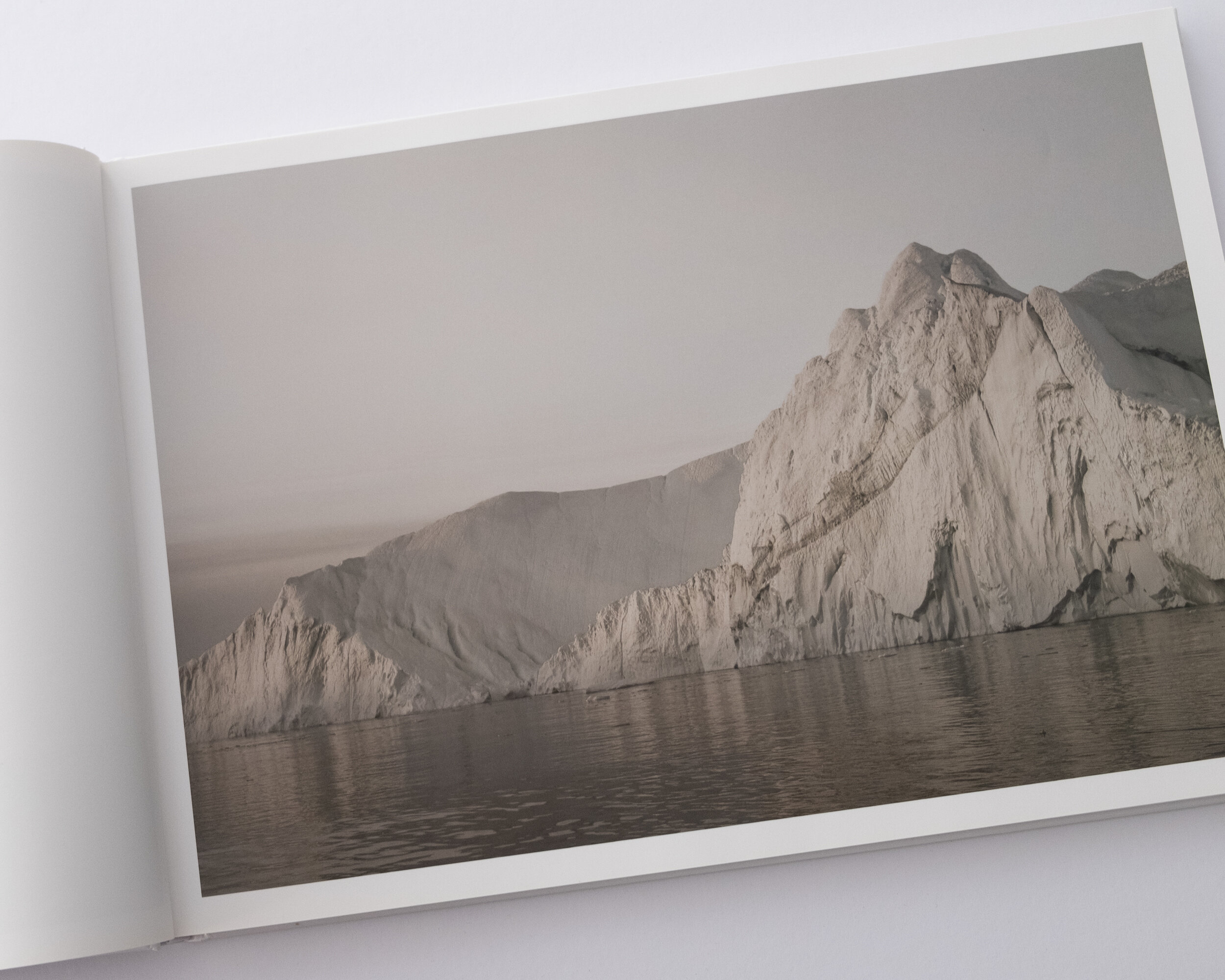Melt: Portrait of an Iceberg
Specifications:
Height_ 420mm
Width_ 297mm
Total Pages_ 100 (including a foreword by the photographer)
ISBN_ 978 0 646 52172-5
Ever since I can remember I’ve been fascinated by the way the decisions I make determine the paths that I’ll take on my journey through life. Decisions we make at any given time determine the shape of the rest of our lives. Each road leads to other roads and those roads lead to still others and so on: an infinite number of options. Some roads might intersect, or even lead to the same destination; but there are some from which there is no turning back.
I set foot on the most crucial of my roads of no return when I was eleven years old: I had decided to paint a picture of the Titanic colliding with the iceberg. I don’t really know why I decided to paint a picture, or why this subject came to me, but three years later, I was still painting. I had become deeply interested in art and art history. I spent hours painting and looking at reproductions of paintings by major artists, many of whom are still my main source of inspiration. Then came another road, another option. Photography was offered as an option at school. I signed up for the class thinking of it as nothing more than a way of documenting things I might want to paint. When I developed my first photo, when I saw the image coming clear, everything changed. I felt something I’d never felt before: intense, absorbing, wholly personal. The word ‘vision’ took on a whole new meaning. I knew for sure that photography would be the great passion of my life.
I often think back to the moment when I decide to paint the iceberg, and the path that that decision took me down. I have no doubt that the journey I’m on now is linked to this one definitive moment in my life. The body of work that constitutes “Melt” could never have come into being any other way. During my research into the Titanic disaster, I discovered that the iceberg had almost certainly traveled down Iceberg Alley an area off the West coast of Greenland where icebergs break away from the ice-wall and travel from Baffin Bay to the East Coast of Newfoundland and Labrador, and then enter the shipping lanes.
This portfolio begins with images of the massive icebergs as they enter Greenland’s Disco Bay from the Ilulissat Icefjord; it ends with the icebergs off the East Coast of Newfoundland, by which time they have traveled hundreds of miles, and have been so battered and broken down that they are little more than ghosts of what they once were. Seeing them first overpowering in grandeur and then, later, about to be absorbed back into the flux from which they came, is both beautiful and humbling: a metamorphosis that endows them with a life-span, each with it’s own personality, each with it’s own story. This project had its origin in a wholly personal moment; a personal journey. It is impossible, however, to look at these images and not think of the environmental issues we face right now. Just as the choice I made in my childhood in some ways defined me as a man, so the choices we are making as a species will define who we become, and what becomes of the planet on which we live.
Salt Moon
A collaboration between photographer Simon Harsent and poet David Harsent. Printed by Guillemot Press as a limited edition section sewn hardback on Mohawk Superfine papers, with embossed casebound cover and printed dust jacket.
Specifications:
Height_ 190mm
Width_ 290mm
Total Pages_ 60
ISBN_ 978-1-916060-55-5
David Harsent
I first saw Simon’s Salt Moon sequence some years ago. I was moved and oddly perturbed by the cold beauty of the images. It was like being reminded of something that hadn’t yet happened. Much later, the first two or three lines of poetry fell into my mind and the first fragments of a narrative formed. I could hear a music, but wasn’t sure whether it was his music or mine. I think it was the subtle variations in his images that gave rise to staged repetitions – a sort of ostinato - in the poems.
Simon Harsent
In the calmest sea, in the stillest waters, there is always movement. This series of photographs presents the viewer with a fixed record of the fleeting forms of light and water – capturing the transient and elusive nature of both sea and moon from a constant point. The moon, acting as both light source and active protagonist, controlling as it does the ebb and flow of the tide, is seen against the sea’s canvas. The image becomes fractured against this moving backdrop and the resulting fragments, these splinters of light, combine to provide a record of a particular moment in time, as individual and unrepeatable as a fingerprint.
The Tears of Hinehukatere
Specifications:
Height_ 210mm
Width: 297mm
Total Pages_ 50
There is a Maori legend used to explain the beautiful geological anomaly of Ka Roimata o Hinehukatere ('The tears of Hinehukatere'). We know this place as Franz Josef Glacier on the West Coast of New Zealand’s South Island.
The story is that of a young woman, Hinehukatere who had a passion for climbing mountains, and like most people with a passion, wanted to share it with her lover, Wawe. An inexperienced climber, Wawe was caught in an avalanche, and fell from the peak to his death, leaving Hinehukatere alone, her streams of tears eventually forming the glacier. The truth of the matter, that the phenomenally fast moving glacier, whose seemingly cyclical ebb and flow has fascinated scientists for years, is the result of the planet’s complex and shifting climate is, perhaps, less poetic, but no less wondrous.
GBH Great Britons Hooligans an Exhibition catalogue. Photographs by Simon Harsent and essay by Barnaby Harsent.
Soft Cover
36 pages
320mm x230mm
Exhibition catalogue
20 Images and a 5000 word essay
‘What club do you support?’ It’s a familiar question, particularly in Britain where affiliation to a football team is often dictated by matters of family loyalty or geography. It is a tribal matter. So much so that a better question might be, ‘What club do you belong to?’
This was the ambient noise of Simon Harsent’s childhood, growing up in England during the 1970s and 80s. Accompanying the football chatter of the back pages, however, were the front-page grumblings. There was an ugly side to the beautiful game that was, if the tabloids were to be believed, the single biggest threat to civilized society. Hooliganism.
It was an easy route for the press to take, and middle England followed happily, waving its indignant fist. ‘Mindless Morons’ they cried, ‘Savages! Animals!’ But things are rarely as black and white as the papers would have us believe. Against a backdrop of social discontent: strikes and the war on unions, the start of the social-housing sell-off and the vicious individualism that passed for policy in the Thatcher years, the working class was under threat. The idea that the moral fabric of the country could be casually ripped apart like a poorly stitched replica kit by two firms having a tear-up on a Saturday afternoon can easily be seen as just another broadside. Particularly when a government-sanctioned gang of young, working-class men was busy killing people 8,000 miles away in the Falklands. A turf war is a turf war.
So, while the press at Port Stanley reported on the heroics of ‘our boys’, disenfranchised young men at home saw their lives re-cast by the same media as one-dimensional, pantomime villain walk-on parts with nothing of value to offer.
Is there an argument for shifting our perspectives? Where does the truth lie? While GBHdoesn’t deal in absolutes, it does take a close look at the men involved in this social phenomenon, as well as the themes ever-present in Harsent’s work: the paths we take, choice and determinism.



















